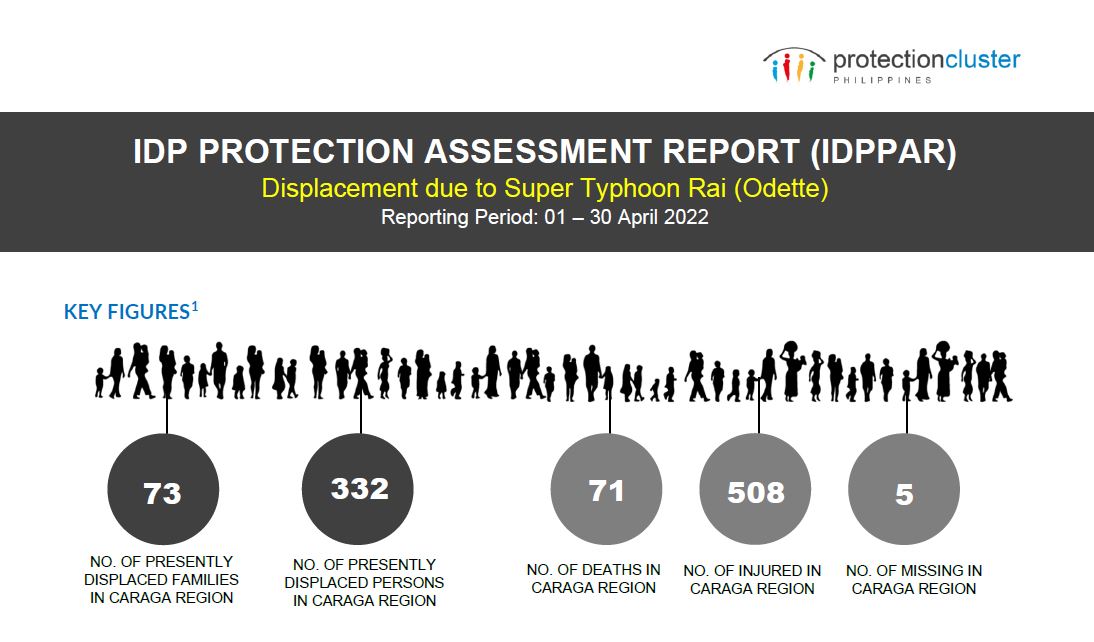IDPPAR No. 02, 2022: Displacement due to Typhoon Rai (Odette), Issue No. 04
INCIDENT BACKGROUND
Super Typhoon Rai (local name Odette) swept through the Philippines and made its first landfall on 16 December 2021 in the coastal areas of Surigao del Norte, Dinagat Islands, Southern Leyte, Cebu, and Bohol. The typhoon brought with it torrential rainfalls, violent winds, floods and storm surges leaving awake of destruction on its pathway.
As of 19 December 2021, around 77,000 families (approximately 298,000 persons) from 531 barangays across the five provinces of the region was affected by the typhoon. Some affected populations who pre-emptively evacuated have already returned home, but others whose houses were partially or totally damaged decided to stay in evacuation centers. Of the total reported affected population, around 66,000 families (approximately 255,000 persons) have sought refuge either inside evacuation centers or in home-based settings.
CURRENT SITUATION
Four (4) months after the onslaught of the Super Typhoon Rai (locally known as Odette) in December 2021 that caused not only massive displacement but also loss of life and damage to properties, more than 6,000 people remain displaced. To date, a total of over two (2) million people have been reportedly affected by the typhoon. Out of this numbers, a significant number of individuals are still living in evacuation centers waiting for the government’s relocation. According to the government’s Disaster Response Operation Monitoring and Information Center (DROMIC) report as of end of April 2022, 73 families or approximately 332 individuals remain in 6 evacuation centers in five (5) provinces in Caraga, while 1,549 families or approximately 5,898 individuals remain displaced in Southern Leyte.
While response slowly transitions to early recovery and many families have already returned to their places of origin, many people are still left in complete devastation without stable shelter, access to essential services and health care, adequate food supply, and access to protective services. Given the extent of damage left by the typhoon, the affected families anticipate that it may still take some time to reach full recovery. Meanwhile, the No Build Zone (NBZ) policy which discourages communities not to return to the sites of their original homes and preventing them to build along the coastal areas, poses a setback to the ongoing rebuilding efforts. This also further exacerbates the typhoon-affected population’s exposure to protection risks.
Compounding the displaced families’ situation, the Tropical Storm Megi (locally known as Agaton) also struck in early April 2022, across many of the same areas affected by STY Rai/Odette, causing floods and landslides affecting at least 2,260,000 people. Based on initial assessments, food aid and emergency shelter are some of the primary needs expressed by the affected families. However, in light of the upcoming national elections on 9 May, local government agencies are restricted from responding to the situation due to the election ban (COMELEC Resolution No. 10747) which prohibits any public official or employee to release, disburse, or expend public funds effective until 8 May 2022.
While host communities can absorb shocks and fill in humanitarian gaps in providing support to displaced families, the prolonged hosting of IDPs may strain their own food supply and the services within the community which may result to tense relationships and conflict. Even in situations where IDPs are able to return, many of the affected communities remain vulnerable to further displacement due to the lack of concrete support to help in facilitating their recovery. In addition, the lack of consultation with affected population on decisions that affect them also remains to be a gap. This also adds up to the uncertainties, which, in effect causes psychosocial distress among them.

